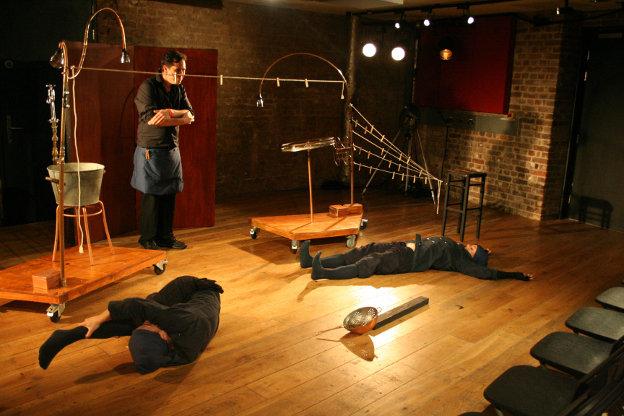Odd Doll Theatre of Puppetry, based in Leeds and making its London debut this month at the Roundhouse, is aptly named. The hero of Odd Doll’s showThe Trick, a large bunraku puppet, is an uncanny figure. He is pale and gaunt, with deep, dark, hollow eyes set in his pale, skeletal head. Bony fingers distinguish his outsized hands, and below his white nineteenth-century style waistcoat hangs a shopkeeper’s apron, on which red stains are visible in spite of what seems to be centuries of bleaching. This weary, searching, inexplicably guilty figure does not look human. He looks like humanity itself, at least in the imaginations of the self-torturing writers Hans Christian Andersen and Franz Kafka.
Two of their short stories inspired the plot of The Trick. In Andersen’s ‘The Shadow’ a man’s shadow turns against him, and in Franz Kafka’s ‘Beyond Law’ a man waits his whole life to be admitted by a cabalistic Gatekeeper to the hidden realm of The Law. Odd Doll’s mashup of these tales locates the nameless hero in a kitchen, where an unseen power has begun making his crockery clatter and leap, and his scissors grow ballerina feet and pirouette in the glowing proscenium of his chiller box. Alternately annoyed, frightened, and intrigued, the cook soon comes face to face with an unnerving alter ego. A ghoulish shadow in a sleek black satin tailcoat; the gatekeeper of the realm inside the chiller.
Initially, this brought to my mind Robert Lepage’s company Ex Machina’s object-theatre rendition of ‘The Shadow’ in The Andersen Project, in which a deeply closeted Paris Opera administrator tells the story to his daughter, illustrating it with an ordinary table lamp. The Trick is not at all derivative of this; in fact, it is more than the sum of the works it adapts. Is an object only a pot, the shadow demands of the man, or has it a hidden life, and why? This question has haunted puppeteers for centuries. Perhaps it is the law that governs such magic to which we desire admittance whenever we present our ticket at the entrance to an auditorium.
The two puppets, hero and shadow, are adeptly manipulated by puppeteers Kathleen Yore and Rebekah Caputo, the latter of whom won a Total Theatre Award in 2006 with the company Chotto Ookii. The characters’ head, hand, and body movements are clearly defined yet subtle enough to seem real, with the man moving cautiously and carefully, and the shadow often spinning and lurching in whimsical glee. Yore and Caputo hide themselves in black costumes, in keeping with bunraku tradition.
Odd Doll’s drapery skills are also impressive. The black satin tails of the Shadow’s coat float like a pair of runaway wind socks and the hero’s apron makes him statuesque.
The set clarifies the story without overwhelming it. Its prominent features are a clothesline adorned with clacking wooden pins and the chiller, which is fixed on top of a black monolith, making it seem an icy planet floating in space. The metal kitchen equipment provides fantastic sound effects during the object-theatre.
The dialogue is absolutely minimal, but the tension between the man and his shadow is boosted by a jittery piano score, played by Paul Mosley.
Slightly less impressive is Odd Doll’s transposition of their touring show to the Roundhouse’s Studio. The seating is not raked, and some of the action takes place on the floor downstage. From the second row, the objects they were manipulating were not at all visible. In these moments, what was going on had to be inferred from sound alone. This is unfortunate because in a nearly-wordless show, it is vital that every moment be visible, and engaging.
However, with The Trick Odd Doll establishes itself as an important voice in puppetry. Yore, Caputo and Mosley venture well beyond mere adaptation of Andersen and Kafka to make their own compelling mythology.


